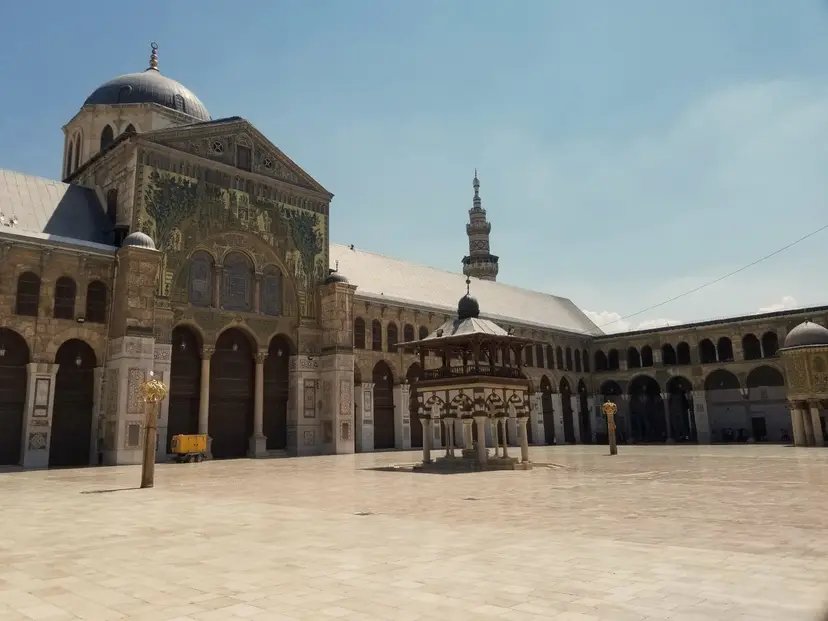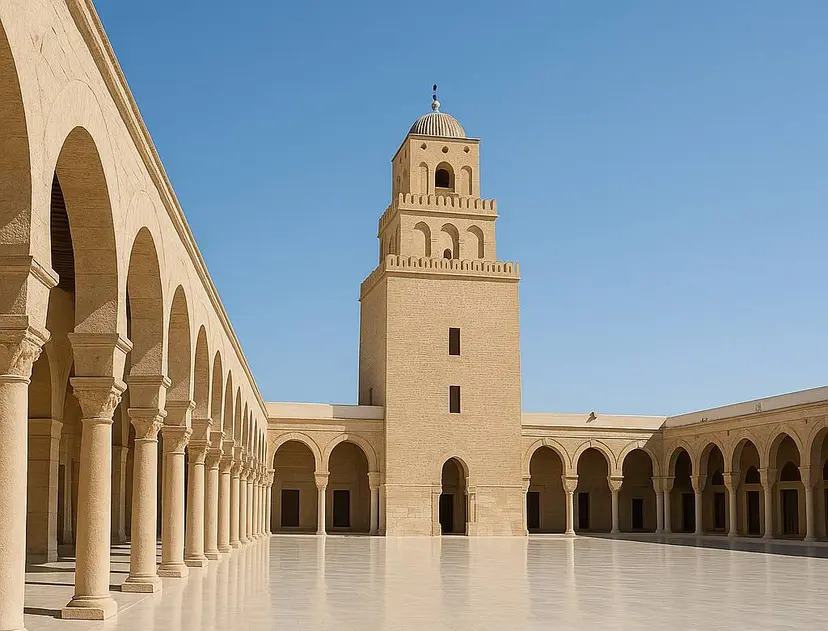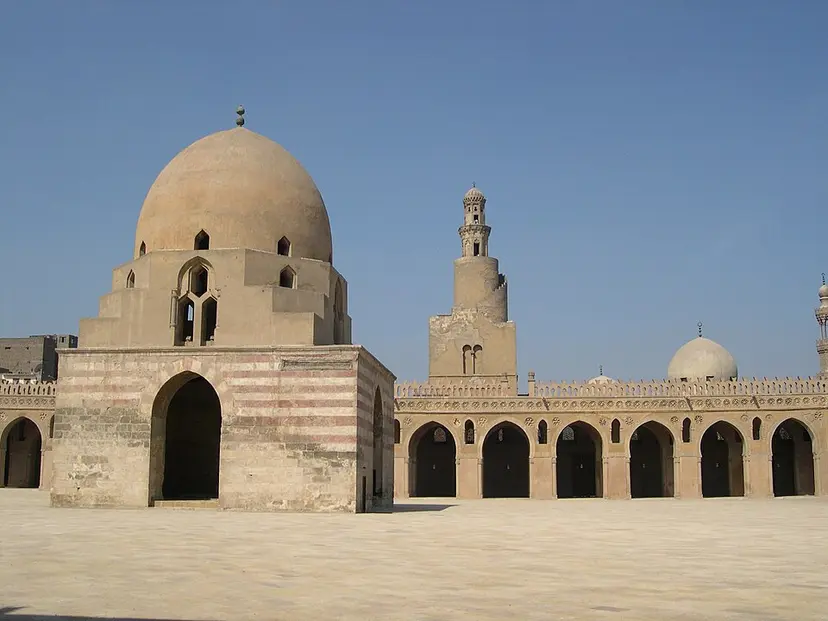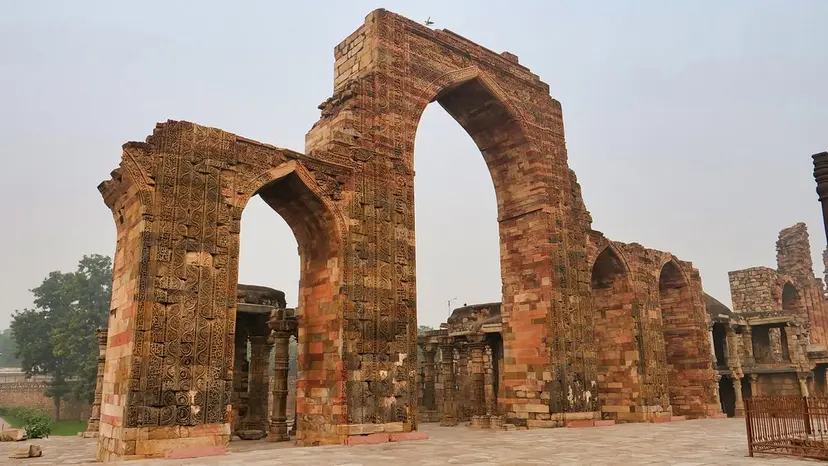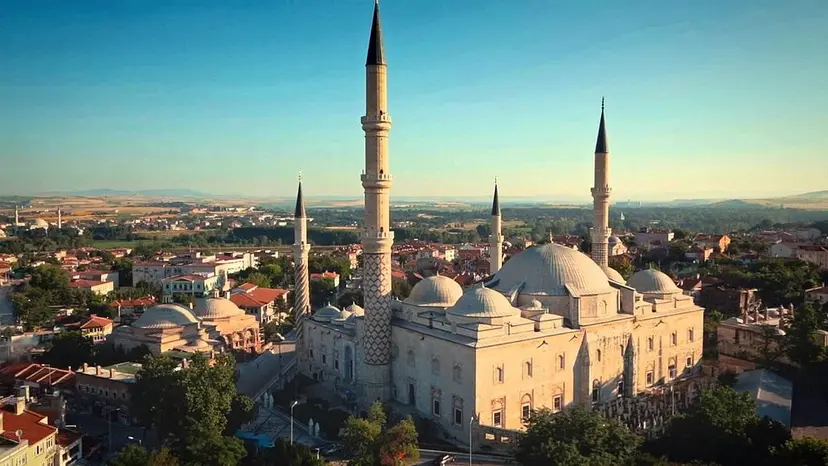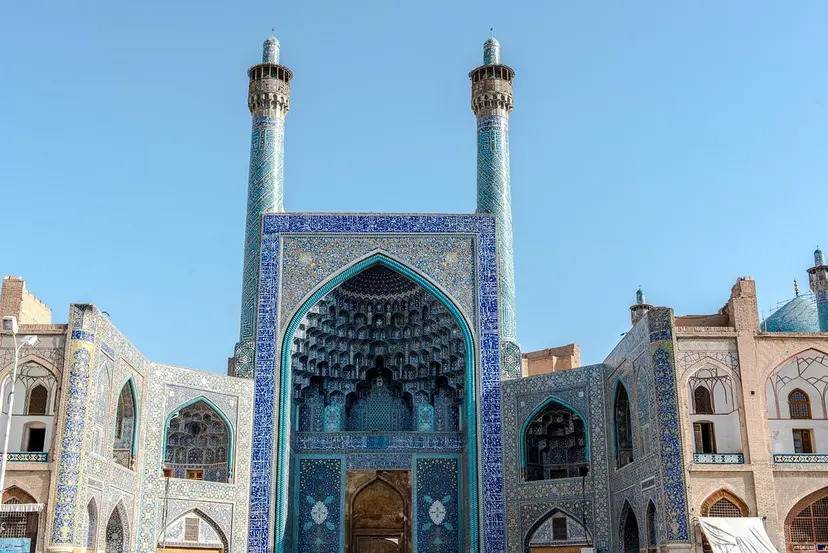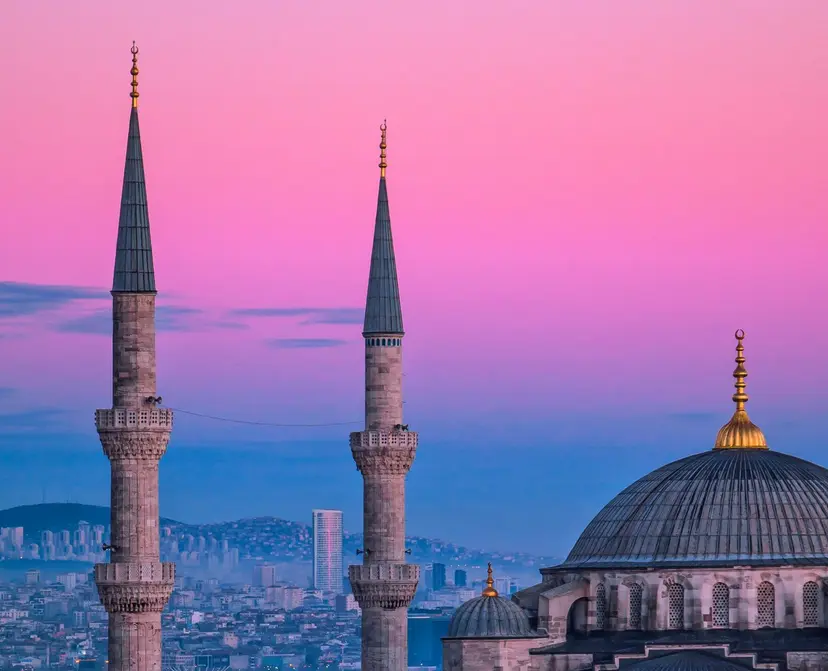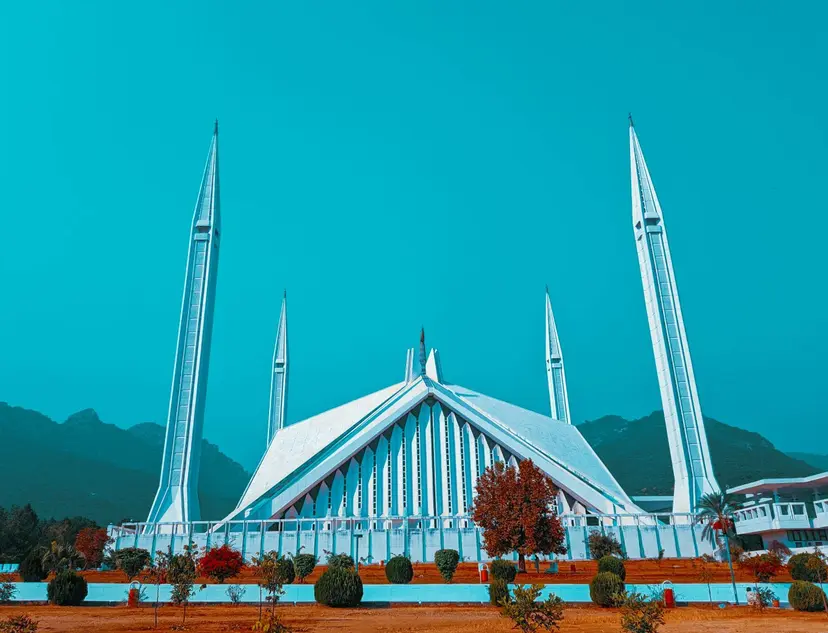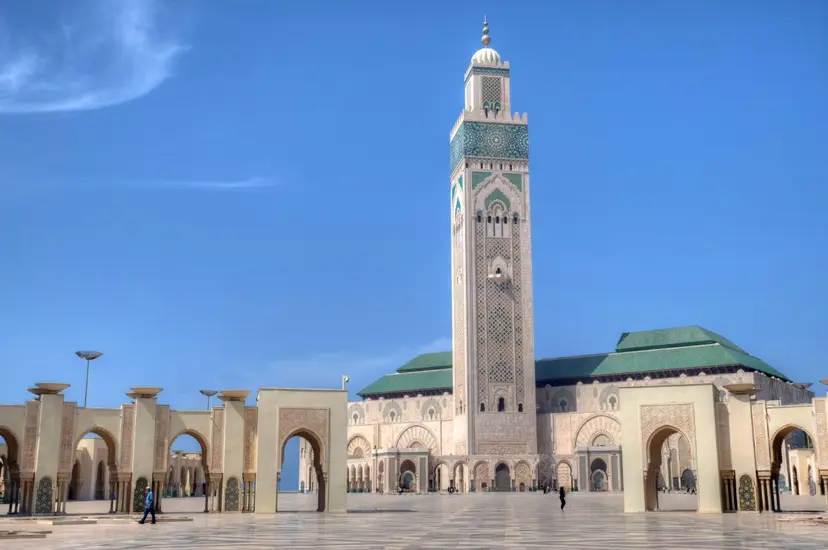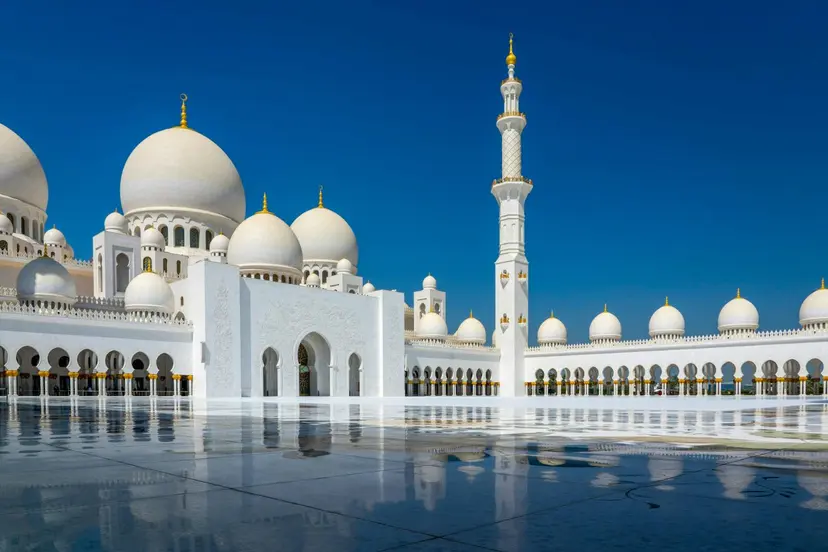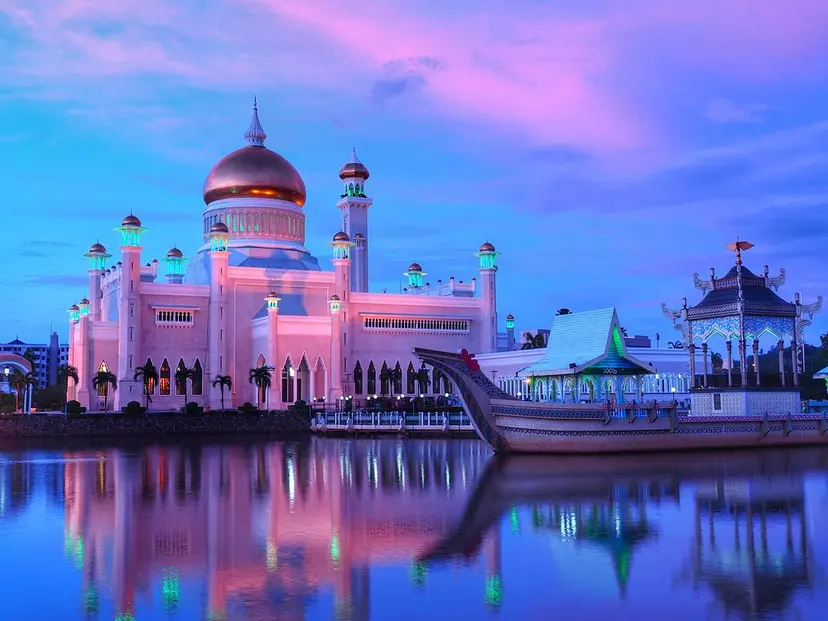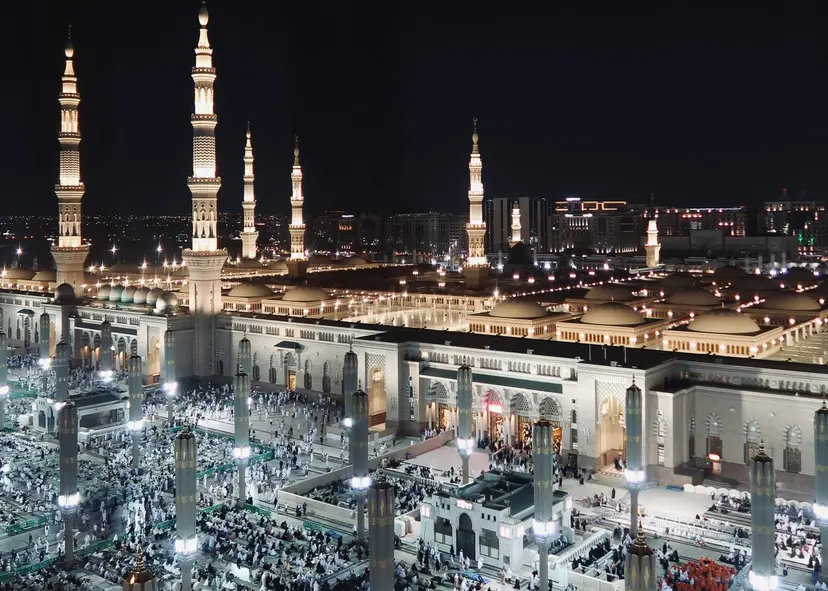Les 12 plus belles mosquées du monde
Bismillahir-Rahmanir-Rahim (Au nom d'Allah, le Tout Miséricordieux, le Très Miséricordieux) !
En vérité, la première Maison établie pour l'humanité fut celle de Bakkah (La Mecque) – bénie et une guidance pour les mondes (Saint Coran 3:96). La Kaaba sacrée de la Grande Mosquée de La Mecque est la Qibla, la direction vers laquelle tous les musulmans tournent leurs visages pendant la prière (salah), et la destination du pèlerinage (Hajj). Les mosquées (masjids – lieux de prosternation) elles-mêmes sont les maisons bénies d'Allah Subhanahu wa Ta'ala sur terre, où les croyants se rassemblent pour la prière en congrégation, le souvenir du Tout-Puissant (dhikr), et le renforcement des liens de fraternité.
Bien que l'Islam ne prescrive pas de règles strictes pour l'architecture des mosquées, à part l'orientation vers la Qibla, les musulmans à travers les âges se sont efforcés d'embellir les maisons d'Allah, reflétant dans leur beauté et leur grandeur la Gloire du Créateur et leur amour pour Lui. L'architecture des mosquées a absorbé les meilleures traditions des cultures locales, les particularités climatiques et le talent des maîtres bâtisseurs, créant une diversité étonnante de styles unis par un seul but – servir de lieu de culte au Dieu Unique.
Nous vous présentons douze mosquées dont la beauté et la signification spirituelle inspirent crainte et révérence chez les croyants du monde entier.
1. Mosquée des Omeyyades (Damas, Syrie, 8e siècle)
Cette ancienne mosquée, l'une des plus anciennes et des plus vénérées au monde, fut érigée à Damas, la capitale du Califat Omeyyade, au début du 8e siècle, sur un site considéré comme sacré depuis des siècles. Désirant souligner non seulement la grandeur de la nouvelle mosquée mais aussi sa signification spirituelle pour les habitants de Damas, le Calife Al-Walid Ier aurait dit aux citoyens : "Vous êtes élevés au-dessus du reste du monde par quatre choses : votre climat, votre eau, vos fruits et vos bains. À cela, je souhaite ajouter une cinquième – cette mosquée."
Des maîtres byzantins invités ornèrent la mosquée de superbes mosaïques représentant des jardins paradisiaques, qui devinrent une image de Jannah (Paradis) pour les musulmans. La spacieuse salle de prière avec de hautes arcades et une immense cour ouverte avec une fontaine pour les ablutions (sabil) créent une atmosphère de paix et de révérence. On croit que l'un des premiers minarets, d'où était lancé l'appel à la prière (adhan), apparut ici.
La mosquée abrite avec respect des reliques : une parcelle de la tête du Prophète Yahya (Jean-Baptiste, paix sur lui), ainsi qu'un sanctuaire avec la tête de l'Imam Hussein (qu'Allah l'agrée), le petit-fils du Prophète Muhammad ﷺ. Il existe une tradition selon laquelle l'un des minarets de la mosquée, le Minaret d'Isa (Jésus, paix sur lui), sera le lieu où le Prophète Isa descendra avant le Jour du Jugement. Près de la mosquée reposent les restes du grand Sultan Salah al-Din (Saladin), le libérateur de Jérusalem, ce qui ajoute une profondeur historique et spirituelle à ce lieu.
2. Mosquée de Sidi Uqba (Kairouan, Tunisie, 7e-9e siècles)
Fondée par le compagnon du Prophète ﷺ, Uqba ibn Nafi (qu'Allah l'agrée), en 670 lors de la fondation de Kairouan, cette mosquée devint le centre de la propagation de l'Islam en Afrique du Nord (le Maghreb). Kairouan est considérée comme l'un des centres spirituels les plus importants de l'Islam au Maghreb, et la mosquée elle-même est vénérée comme la plus ancienne et la plus importante de la région. Ses murs puissants et ses contreforts lui donnent l'apparence d'une forteresse de l'esprit. Une légende raconte la fondation miraculeuse de la ville et de la mosquée : lorsque Uqba ibn Nafi (qu'Allah l'agrée) enfonça sa lance dans le sol, une source jaillit, et plus tard, une coupe en or fut trouvée, miraculeusement transportée de La Mecque, ce qui devint un signe de la bénédiction de ce lieu.
La Mosquée de Sidi Uqba est un exemple frappant de la formation du style maghrébin distinctif. La cour spacieuse et la salle de prière à plusieurs nefs avec des colonnes provenant d'anciens bâtiments mènent à un mihrab (niche indiquant la Qibla) artistiquement décoré. Le minbar (chaire) en bois sculpté et les panneaux de marbre du mihrab comptent parmi les plus anciens chefs-d'œuvre de l'art islamique. C'est ici que les arcs en fer à cheval furent pour la première fois largement utilisés, devenant la marque de fabrique de l'architecture islamique en Occident.
Pendant des siècles, la mosquée fut non seulement un lieu de prière mais aussi une importante université islamique, et à ce jour, elle reste le sanctuaire et le lieu de pèlerinage le plus important pour les musulmans du Maghreb.
3. Mosquée Ibn Touloun (Le Caire, Égypte, 9e siècle)
Érigée par Ahmad ibn Touloun, le fondateur de la dynastie Toulounide en Égypte, cette mosquée est l'une des plus anciennes du Caire à avoir conservé son aspect original. Ses dimensions énormes et l'absence presque totale de reconstructions ultérieures permettent de ressentir l'esprit de l'Islam primitif en Égypte. On dit que depuis le point d'observation de son minaret unique, on peut voir tout le vieux Caire, comme si le passé et le présent étaient connectés.
Construite en brique, sur le modèle des mosquées du Califat Abbasside en Irak, elle se distingue par sa monumentalité et son austérité de formes. Son minaret unique avec un escalier extérieur en spirale rappelle le célèbre minaret de Samarra. L'immense cour est entourée de galeries couvertes (riwaqs) avec des arcades décorées de sculptures en stuc (gypse) exquises, sans que deux arcs ne soient identiques.
Notamment, les arcs brisés de la Mosquée Ibn Touloun sont considérés comme l'un des premiers exemples de leur utilisation en architecture, bien avant le gothique européen. Une particularité est la présence d'un mur extérieur, créant un espace supplémentaire (ziyada) pour les fidèles lors des grandes fêtes. Au centre de la cour se trouve un pavillon à coupole pour les ablutions. La Mosquée Ibn Touloun impressionne par son harmonie, son espace et sa décoration habile mais sobre.
4. Mosquée Quwwat-ul-Islam (Delhi, Inde, 12e siècle)
Le nom de cette mosquée se traduit par "Puissance de l'Islam". Elle fut fondée à Delhi après l'établissement de la domination musulmane à la fin du XIIe siècle. Le complexe fut construit sur le site et avec les matériaux de temples hindous et jaïns démolis, ce qui créa une apparence architecturale unique. Bien que des éléments de structures antérieures aient été utilisés dans sa construction, une pratique courante à cette époque de changement, les calligraphes et architectes islamiques les transformèrent, les plaçant dans un nouveau contexte de glorification du Dieu Unique.
La structure de la mosquée (une grande cour entourée de galeries) montre une influence persane, mais l'exécution fut réalisée par des artisans indiens. Les colonnes et les plafonds ont conservé leurs sculptures hindoues complexes, y compris des images figuratives. Cette combinaison de calligraphie islamique sur le portail d'entrée et de sculpture indienne traditionnelle fait de la mosquée un témoignage de l'histoire complexe de l'interaction culturelle sur le sous-continent indien.
Dans la cour du complexe se dresse le célèbre pilier de fer des 4e-5e siècles, une relique de l'ère pré-islamique qui a résisté à la rouille pendant 1600 ans – un témoin silencieux des époques et cultures changeantes de cette terre. L'élément dominant du complexe est le grand Qutb Minar, le plus haut minaret de brique de son genre au monde. Le Qutb Minar lui-même est orné de sculptures complexes et de versets du Saint Coran, proclamant la grandeur d'Allah et la victoire de l'Islam.
5. Mosquée Üç Şerefeli (Edirne, Turquie, 15e siècle)
Construite à Edirne, l'ancienne capitale de l'Empire ottoman, sous le règne du Sultan Mourad II, cette mosquée a marqué une étape significative dans le développement de l'architecture ottomane. Son nom – "Mosquée aux Trois Balcons" – est lié à l'un de ses minarets, qui possède trois plates-formes pour le muezzin (şerefe). Étonnamment, à l'intérieur du plus haut minaret, celui à "trois balcons", se trouvent trois escaliers en colimaçon distincts, chacun menant à son propre balcon (şerefe) – une véritable merveille d'ingénierie pour l'époque. L'architecte a audacieusement érigé une immense coupole centrale d'un diamètre de 24 mètres, créant un espace de prière majestueux et baigné de lumière. La structure innovante à six supports de la coupole et l'apparition de cellules latérales à coupole ont donné au bâtiment une composition inhabituelle à cinq coupoles. Cette mosquée a réintroduit une grande cour ouverte entourée de galeries à coupole – une composition devenue canonique pour les mosquées de sultan à Istanbul. Les quatre minarets aux coins de la cour ont marqué le territoire de la mosquée pour la première fois et créé une puissante dominante verticale. La mosquée a survécu à plusieurs tremblements de terre, mais grâce au talent de ses bâtisseurs et aux restaurations ultérieures, elle continue de servir les fidèles et d'impressionner par son aspect innovant du XVe siècle.
6. Mosquée de l'Imam (Shah) (Ispahan, Iran, 16e-17e siècles)
Ce chef-d'œuvre de l'architecture safavide est le joyau d'Ispahan, ornant le côté sud de la majestueuse place Naqsh-e Jahan. La mosquée est un exemple classique de la disposition iranienne à quatre iwans : au centre de la cour, de chaque côté, se trouvent d'énormes portails-niches voûtés (iwans). Pour orienter la mosquée vers La Mecque, elle a dû être tournée à un angle par rapport à la place, une caractéristique habilement dissimulée derrière le portail d'entrée et le vestibule. Toutes les surfaces de la mosquée, tant à l'extérieur qu'à l'intérieur, sont recouvertes de carreaux émaillés brillants. Le revêtement de la mosquée est réalisé selon la technique du "haft-rangi" (sept couleurs), ce qui a permis la création de panneaux complexes et vibrants, transformant les murs en une sorte de jardins célestes. L'énorme dôme principal (52 mètres de haut) possède une acoustique étonnante : un son émis à un point précis sous celui-ci est répercuté plusieurs fois. L'emplacement de la mosquée sur la place principale d'Ispahan soulignait son rôle non seulement en tant que centre spirituel mais aussi en tant que pôle public important de la capitale safavide sous Shah Abbas le Grand. Deux minarets jumelés au portail d'entrée et deux à l'iwan principal complètent l'aspect harmonieux et majestueux de la mosquée.
7. Mosquée Sultan Ahmed (Mosquée Bleue) (Istanbul, Turquie, 17e siècle)
La Mosquée Sultan Ahmed (مسجد السلطان أحمد), plus connue sous le nom de Mosquée Bleue à Istanbul, est l'un des plus grands monuments de l'architecture et de la spiritualité islamiques, construite sur ordre du Sultan Ahmed Ier (qu'Allah lui fasse miséricorde) au XVIIe siècle. Située au cœur historique de la ville, en face de Sainte-Sophie, elle est devenue un symbole de la foi islamique, de la puissance de l'Empire ottoman et de la recherche de la beauté pour le plaisir d'Allah ﷻ.
Érigée entre 1609 et 1616 sous la direction de l'architecte de la cour Sedefkâr Mehmed Ağa, la Mosquée Sultan Ahmed incarne l'idéal d'harmonie entre grandeur et modestie spirituelle. Son extérieur magnifique avec une cascade de dômes et six minarets fit sensation : jamais auparavant une mosquée n'avait eu un design aussi audacieux, rivalisant avec la majesté de la Grande Mosquée (al-Masjid al-Haram). Selon la légende, pour éviter la rivalité, le Sultan ordonna l'ajout d'un septième minaret au sanctuaire principal de l'Islam à La Mecque.
L'intérieur de la Mosquée Bleue est véritablement hypnotisant : plus de 20 000 carreaux de céramique faits à la main d'Iznik, beaucoup dans des tons de bleu, turquoise et azur, créent une atmosphère unique de paix et de lumière. Grâce à 260 fenêtres et un éclairage réfléchi, l'intérieur de la mosquée semble être imprégné de lumière divine – un rappel de la Lumière d'Allah ﷻ, qui guide les cœurs vers la Vérité.
La spacieuse salle de prière peut accueillir des milliers de fidèles et est décorée dans les traditions du style ottoman – avec des tapis faits à la main, un mihrab et un minbar élégants, ainsi qu'un Hünkâr Mahfili spécial (loge du Sultan), destiné au sultan et à ses gardes pendant la prière.
La Mosquée Sultan Ahmed reste aujourd'hui un lieu de prière fonctionnel et l'un des principaux centres spirituels et touristiques de Turquie. Elle est visitée par des millions de musulmans et de touristes du monde entier, qui admirent non seulement sa beauté architecturale mais aussi l'état de paix et de tranquillité qu'elle confère à quiconque entre dans ses murs.
8. Mosquée Faisal (Islamabad, Pakistan, 20e siècle)
La Mosquée Faisal (مسجد فيصل), située à Islamabad, la capitale du Pakistan, est l'une des mosquées les plus grandes et les plus insolites du monde, capable d'accueillir jusqu'à 100 000 fidèles. Construite en 1986 grâce aux fonds donnés par le Roi Fayçal d'Arabie Saoudite, Fayçal ibn Abd al-Aziz (qu'Allah lui fasse miséricorde), elle fut nommée en son honneur et est devenue non seulement une merveille architecturale mais aussi un symbole de fraternité entre les deux pays musulmans.
La conception de la mosquée a été choisie à l'issue d'un concours international : sur 43 projets, c'est le concept avant-gardiste de l'architecte turc Vedat Dalokay qui a été retenu, proposant une forme inspirée d'une tente bédouine et du livre saint – le Coran, ouvert devant le Tout-Puissant ﷻ.
Contrairement aux formes classiques de l'architecture islamique, la Mosquée Faisal ne possède pas de dôme, mais sa puissante géométrie et ses quatre minarets s'élevant à 90 mètres de hauteur créent une sensation d'élévation spirituelle. L'intérieur est conçu dans un style minimaliste : des lignes épurées, du marbre, du verre et un éclairage naturel réfléchi créent une atmosphère particulière de concentration et de paix intérieure.
L'intérieur est orné de calligraphies arabes stylisées et d'éléments décoratifs réalisés par des artisans pakistanais. La salle principale est spacieuse, sans colonnes, et met l'accent sur la liberté et l'unité dans l'adoration d'Allah ﷻ. L'espace devant la mosquée est utilisé pour la prière du Jumu'ah et les grands rassemblements lors de l'Aïd al-Fitr et de l'Aïd al-Adha, réunissant des dizaines de milliers de fidèles.
Située au pied des pittoresques Margalla Hills, la mosquée semble unir les créations d'Allah – la nature et l'architecture, servant de lieu de tranquillité, d'élévation spirituelle et de rappel des vraies valeurs de l'Islam. Il n'est pas étonnant qu'elle soit devenue un symbole national du Pakistan, représentée sur les pièces de monnaie, les cartes postales et dans les manuels scolaires.
9. Mosquée Hassan II (Casablanca, Maroc, 20e siècle)
Cette grandiose mosquée, construite par la volonté du Roi Hassan II du Maroc, est l'une des structures islamiques modernes les plus impressionnantes. Son unicité réside dans son emplacement : une partie significative de la mosquée est construite sur une plate-forme s'avançant dans l'océan Atlantique, incarnant le verset coranique sur le Trône d'Allah sur l'eau (11:7). Il est à noter que les fonds pour la construction de cette grande structure, qui peut accueillir jusqu'à 25 000 fidèles dans sa salle de prière, ont été collectés non seulement par l'État mais aussi grâce à des dons de musulmans de tout le Maroc et du monde. C'est la plus grande mosquée du pays et la septième plus grande au monde. Son minaret est le plus haut du monde à 210 mètres, plus haut que la Pyramide de Khéops. L'architecte Michel Pinseau a habilement combiné technologie moderne et art marocain traditionnel. Les meilleurs matériaux locaux ont été utilisés dans la décoration de la mosquée, et des milliers d'artisans marocains ont ravivé et mis en valeur la beauté des arts traditionnels au monde : la sculpture sur bois et sur pierre, le plâtre gebs et les mosaïques de zellij. Le toit rétractable permet de prier à ciel ouvert. Le minaret carré, conçu dans la tradition maghrébine, est le plus haut du monde et sert de phare pour les navires, et la nuit, un faisceau laser de son sommet pointe la direction exacte de La Mecque.
10. Grande Mosquée Cheikh Zayed (Abu Dhabi, Émirats Arabes Unis, 21e siècle)
Nommée en l'honneur du fondateur des Émirats Arabes Unis, Cheikh Zayed bin Sultan Al Nahyan (qu'Allah lui fasse miséricorde), cette mosquée à Abu Dhabi est frappante par son luxe et sa beauté. Elle semble être tissée de lumière et de marbre blanc, brillant sous le soleil éclatant. Cette mosquée est également devenue le lieu de repos final de Cheikh Zayed bin Sultan Al Nahyan (qu'Allah lui fasse miséricorde), le fondateur des Émirats Arabes Unis, dont elle porte le nom. Sa modeste tombe est située dans la cour de la mosquée.
L'architecture de la mosquée combine harmonieusement des éléments de divers styles islamiques. Lors de sa conception et de sa construction, des artisans et des matériaux du monde entier (d'Italie, d'Allemagne, du Maroc, d'Inde, de Turquie, d'Iran, de Chine et d'autres pays) ont été délibérément impliqués pour en faire une incarnation de l'unité et de la diversité du monde islamique. C'est l'une des plus grandes mosquées du monde. Sa construction a coûté environ 550 millions de dollars et a duré 12 ans, au cours desquels 3 500 ouvriers de 38 entreprises du monde entier ont travaillé sur ce grand projet. Elle peut accueillir jusqu'à 41 000 fidèles.
La mosquée est ornée de 82 dômes, d'un millier de colonnes et de lustres dorés à la feuille d'or. Les murs et les colonnes d'un blanc immaculé sont incrustés de marbre coloré et de pierres semi-précieuses, formant des motifs floraux exquis. L'abondance d'ornements et de motifs floraux dans l'incrustation de marbre symbolise le Jardin du Paradis et la beauté de la création d'Allah dans toute sa diversité. À l'intérieur, la salle de prière est décorée de sept immenses lustres avec des cristaux Swarovski, et le sol est recouvert du plus grand tapis persan noué à la main du monde. Les nombreux dômes et les quatre minarets créent une silhouette impressionnante. Des bassins réfléchissants et un système d'éclairage nocturne complexe rehaussent son charme magique. Le jour, le bâtiment brille de blanc et d'or sous le soleil, et la nuit, il est baigné de lumière artificielle.
11. Mosquée Sultan Omar Ali Saifuddin (Brunei)
La Mosquée Sultan Omar Ali Saifuddin est un joyau de l'Islam en Asie du Sud-Est.
La Mosquée Sultan Omar Ali Saifuddin, dans la capitale de Brunei, Bandar Seri Begawan, est à juste titre considérée comme l'une des plus belles mosquées du monde. Cette majestueuse maison d'Allah ﷻ est devenue un symbole de l'architecture islamique et de l'élévation spirituelle en Asie du Sud-Est.
Construite en 1958 à l'initiative du 28e Sultan de Brunei – Omar Ali Saifuddin III, qu'Allah l'agrée – la mosquée est située sur une lagune artificielle sur la rivière Brunei. Son apparence élégante semble flotter sur l'eau, rappelant la pureté (taharah) et l'aspiration à un culte sublime.
L'architecture de la mosquée combine les traditions de l'architecture islamique et le style européen. Marbre blanc immaculé, dômes recouverts d'or et un minaret de 44 mètres s'élevant vers le ciel – tout cela reflète la grandeur moghole et le raffinement italien, servant de rappel de la lumière de la Vérité et de la grandeur d'Allah ﷻ.
L'intérieur de la mosquée est frappant par son luxe et son attention aux détails. Marbre d'Italie, vitraux et lustres du Royaume-Uni, tapis d'Arabie Saoudite et de Belgique, et mosaïques de Venise, composées de plus de 3,5 millions de pièces de verre – tout crée une atmosphère de paix, de révérence et de concentration spirituelle pendant la prière.
Les jardins autour de la mosquée avec des fontaines, inspirées des descriptions de Jannah dans le Saint Coran, procurent tranquillité et invitent à la contemplation. Ce n'est pas seulement une merveille architecturale, mais un lieu où les cœurs des croyants renforcent leur lien avec le Créateur et ressentent Sa Miséricorde.
12. Masjid an-Nabawi (Médine, Arabie Saoudite)
Masjid an-Nabawi (المسجد النبوي الشريف) est l'un des plus grands sanctuaires de l'Islam, situé dans la ville bénie de Médine, en Arabie Saoudite. C'est la deuxième mosquée la plus importante après Al-Masjid al-Haram à La Mecque et le lieu que le Prophète Muhammad ﷺ lui-même a construit après l'Hégire de La Mecque.
Masjid an-Nabawi est également connue sous le nom de Mosquée du Prophète ﷺ, car c'est ici que se trouve sa tombe bénie, que la paix et les bénédictions d'Allah soient sur lui. Au centre de la mosquée se dresse le Dôme Vert (القبة الخضراء) – un symbole du respect le plus profond et de l'amour des musulmans pour le Messager d'Allah ﷺ. Le premier dôme fut érigé en 1279, et en 1837, il fut peint en vert, ce qu'il est resté jusqu'à ce jour, devenant l'un des symboles les plus reconnaissables du monde islamique.
Masjid an-Nabawi est devenue un modèle pour des milliers de mosquées à travers le monde. Son architecture a établi le canon de la mosquée à colonnes : une cour rectangulaire ouverte, une salle à colonnes et une orientation vers la qibla – d'abord vers Jérusalem, puis, sur l'ordre d'Allah ﷻ, vers La Mecque.
Aujourd'hui, la salle de prière principale occupe tout le premier étage et peut accueillir jusqu'à 500 000 fidèles à la fois, en particulier pendant le Hajj et le Ramadan. La mosquée compte 10 minarets, chacun s'élevant à 105 mètres de haut, comme des témoignages du Tawhid – l'Unicité de Dieu – atteignant les cieux.
La Mosquée du Prophète ﷺ n'est pas seulement une merveille architecturale, mais aussi un centre spirituel où des millions de musulmans effectuent chaque année la Ziyarat (visite) avec des supplications sincères, renforçant leur foi et leur amour pour le Messager d'Allah ﷺ. Selon le hadith du Prophète ﷺ :
(Une) prière dans cette mosquée est meilleure que mille prières dans toute autre mosquée, à l'exception de la Mosquée Sacrée.
Conclusion
Ces douze mosquées ne sont qu'une petite partie des innombrables maisons d'Allah dispersées à travers le globe. Chacune est unique, mais toutes servent un seul but – être un lieu où les cœurs des croyants se tournent vers le Créateur Unique en prière, humilité et gratitude. Qu'Allah accepte les prières de tous les musulmans et préserve ces lieux bénis !
